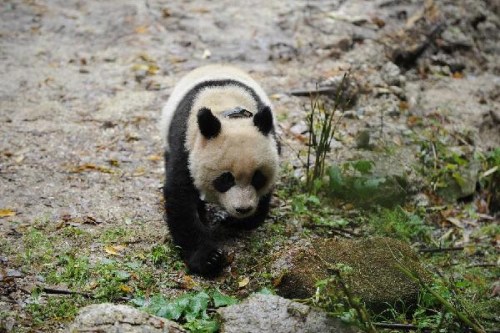
Giant panda Tao Tao crawls to the wild mountain forest in the Liziping nature reserve in Shimian County of Ya'an City, southwest China's Sichuan Province, Oct. 11, 2012. As the first artificially raised giant panda released to the nature in China, Tao Tao's condition will be tracked after its reintroduction. Six more giant pandas are under the systematic wildness recovery training as Tao Tao, in the Wolong Giant Panda Protection and Research Center. (Xinhua/Li Qiaoqiao)
China on Thursday sent an artificially bred and trained panda into the wild in the southwest of the country, a move which authorities said marked a new phase for the nation's panda protection efforts.
Born in the Wolong Nature Reserve in Sichuan province in August 2010, "Taotao" is male and two years old. At 10:13 a.m. Thursday, it walked out of its cage, ran straight toward a bamboo forest in the Lipingzi Nature Reserve in Sichuan's county of Shimian, and embraced its new life.
The release of Taotao to nature was the second of China's such efforts after it set free five-year-old "Xiangxiang" in 2006. However, the first try failed after Xiangxiang died during fights with other wild pandas for food and territory about a year after release.
Scientists and experts later drew upon from the experience and improved training methods. In June 2010, the nation resumed small-scale training programs for pandas before returning them to nature. The new training focused on the panda cub learning from its mother.
"As opposed to Xiangxiang's captive-bred environment, Taotao has lived and grown in semi-wild conditions since being very little. This means that its fighting capability and survival skills both improved significantly," said Zhang Hemin, director of the China Conservation and Research Center for the Giant Panda.
Before Taotao's release, it had gone through three rounds of training in preparation for going back to the wild, according to the State Forestry Administration and the Sichuan provincial government, which jointly organized Thursday's panda release.
Firstly, it was fed and raised by its mother, and learned basics such as climbing from the older animal. Secondly, Taotao withstood mud-rock flows, snow disasters and rainstorms with its mother, all the while improving its basic skills. It learned to fear humans and hide from them. During the third session, Taotao was trained to recognize enemies and its own kind.
"Sending artificially bred pandas back to nature after providing them with training will help them integrate with wild pandas. This will be conducive to improving genetic diversity among wild pandas regionally, increasing the number of wild pandas, and enhancing their survival capabilities," according to Wu Daifu, Taotao's feeder.
However, Zhang Hemin worried whether Taotao will pull through the difficulties in inevitable competitions with wild pandas and avoiding natural enemies such as bears, leopards and wolves.
"Even though we have used new training methods, Taotao is only the second such panda released to nature, and we remain at the experimental stage," said Zhang.
Experts said the returning of artificially bred pandas to the wild shows that China has entered a new stage in its panda protection efforts. So far, the country has established 64 nature reserves for pandas, facilities which have offered effective protection to more than 70 percent of its wild pandas.
The number of wild pandas in China has increased to more than 1,600. Meanwhile, the number of captive-bred pandas stands at 342, according to Yin Hong, vice chief of the State Forestry Administration.

Copyright ©1999-2011 Chinanews.com. All rights reserved.
Reproduction in whole or in part without permission is prohibited.